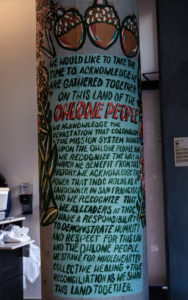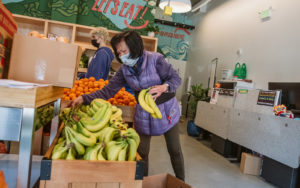If you’ve ever walked through San Francisco’s Mission Bay, you know the district is new and modern, home to Bay views, public parks, and the iconic Chase Center. Much of the neighborhood is recently developed, and adding to the spirit of transformation in the district is a new kind of food pantry: Kain Na Community Food Hub, which opened its doors on February 4 this year.
Kain Na was informed by the Mission Bay community and is operated by the Tenderloin Neighborhood Development Corporation (TNDC) to provide free nutritious and culturally relevant food in an open market space. Food is provided by the SF-Marin Food Bank and the Deep Medicine Circle.

“TNDC has a successful and powerful legacy of engaging the community and taking direct action to meet people’s needs,” said Maurilio León, TNDC CEO. “Kain Na is an example of our values and the impact we can make in advancing food and health justice.”
Walking into Kain Na, which means “Let’s Eat” in Tagalog, it’s clear that the space was designed to welcome people inside. The name itself pays homage to the Filipino community of San Francisco and celebrates the universal language of food. Local artist ChiChai covered the walls with murals, including a prominent acknowledgment of the Ohlone land the building occupies. Paintings show people coming together and sharing platters of food, mirroring the abundant selection of fresh produce, meat and eggs, and pantry staples filling the food hub’s aisles.
Kain Na is a multifunctional space, and the rows filled with produce during market hours can be reworked into tables where food and nutrition classes are held. Cookbooks and pamphlets fill some of the shelf space. The space is bright, clean, and welcoming – much like the Mission Bay neighborhood it occupies. Located on the ground floor of TNDC’s supportive housing 626 Mission Bay Boulevard, Kain Na serves many building residents and is part of a holistic approach to addressing the root causes of food insecurity.
A Shift to Empowerment
Kain Na builds on the concept of a food pantry to offer even more choice and flexibility. Many food pantries are open for only a few hours once a week. For many participants, having a set appointment time is convenient – parents know they can grab groceries when they pick up their kids from school, or people who work during the week can depend on their Saturday time slot without needing to wait in line while doing their weekend errands. Kain Na, on the other hand, takes a flexible approach by staying open all day for several days a week, a better option for someone who has a more unpredictable schedule.
“If a participant can’t make it one day to get their weekly food, they can visit the hub on the other days it’s open,” said Tina Gonzales, the Food Bank’s Director of Community Partnerships. “This reduces anxiety and fear of scarcity, making the food hub a positive shopping experience.”

The food pantries run by our partners like TNDC are committed to serving people with dignity, and one of the key elements of that is offering choice. Before the pandemic, all our pantries were set up like farmers’ markets, where participants were free to select the amount and type of food they received. For the last two years, we’ve had to pivot to pre-bagging groceries for our participants – but we’re working to bring back the empowerment inherent in folks choosing their own food in a farmers’ market setting. Kain Na is a great example of how to offer food options safely going forward.
“It gives participants the choice to pick the food they need to feed themselves and their families,” said Tina. “Participants grab a watermelon when they are in season because their kids like the fruit. If they want to skip receiving 10 potatoes one week, they can choose the four potatoes they need instead.” This allows pantries and hubs to adjust their offerings to include foods they see their community wants.
Kain Na also serves as an information center with free food and nutrition workshops. “It offers other community resources to improve participant wellbeing,” said Tina. “Things like CalFresh (food stamps) outreach, eviction defense resources, tax assistance, and summer programming for kids make Kain Na a community resource as much as it is a food program.”
At the Food Bank, we’re looking to Kain Na Community Food Hub as an example of what some food pantries could look like in the future. It is offering yet another kind of service to help meet people where they are at. The food hub’s insight into what strategies work best to solve food insecurity in a post-COVID world will be invaluable. We’re proud to support TNDC and Kain Na in trailblazing solutions to hunger in San Francisco.


Share